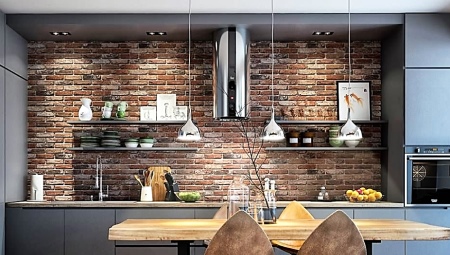The kitchen is a special room in the house, because it is not only a place for cooking, but also a room for meetings with friends and acquaintances. To create a cozy atmosphere in it, you should carefully consider the layout and choose the right material for surface finishing. Despite the fact that designers create projects using various materials, stone decoration is very popular.
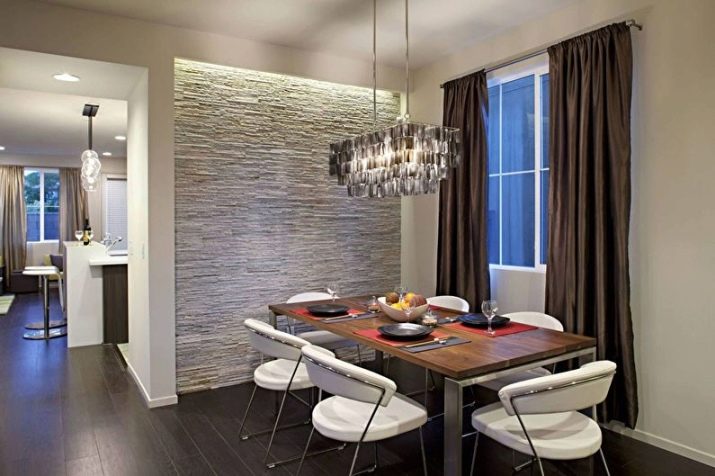
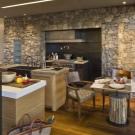
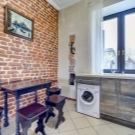
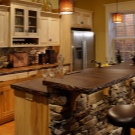

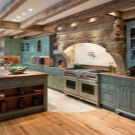
Advantages and disadvantages
Decorative stone serves as a real decoration of any interior, as it attracts with its volume and natural texture. Kitchens lined with this material look stylish and expensive. In addition, he has many other advantages.
- High strength. According to laboratory studies, the stone in its endurance is in no way inferior to iron and steel.
- Moisture resistant. Decorative stone also does not respond to changes in humidity and does not absorb water at all. Due to these properties, mold and fungus never appear on the surface of the cladding.
- Durability. Artificial stone, like natural stone, is not subject to mechanical stress, therefore it lasts forever.
- Chemical resistance. Decorative stone is considered an excellent choice for kitchen decor, since it can be washed with any detergents, including those that contain an aggressive chemical composition.
- Maintainability. Upon receipt of any damage, including splits, the stone can quickly return to its original form.
- Aesthetics. The texture of the stone is unusual, it gives the kitchen an attractive appearance and sophistication.
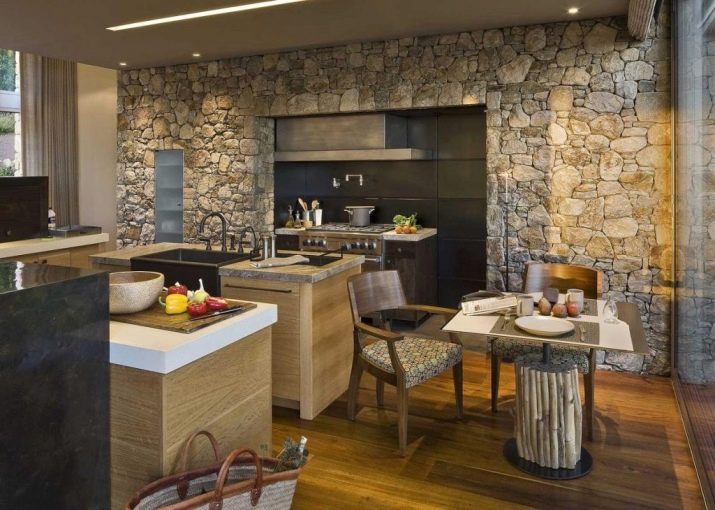
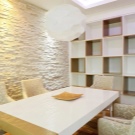
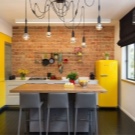

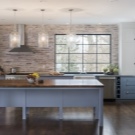
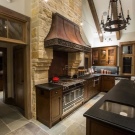
Now consider the inherent disadvantages of decorative stone.
- High price. Stone decoration is not an economical option: if you plan to carry out budget repairs, it is best to give preference to artificial material. It costs much less and is in no way inferior in terms of performance.
- Cold surface. Despite the fact that the stone fits perfectly into any modern interior, it has poor thermal conductivity.

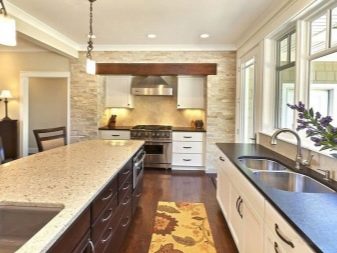


Species overview
Facing surfaces in the kitchen can be carried out by various types of decorative stone. Today, depending on the origin, it is divided into artificial and natural. Each of these species has its own operational characteristics, and also differs in appearance.
Natural stone was created by Mother Nature and has found wide application in facing works, it is especially often used in the design of kitchens. It emits unusual energy that positively affects human health. In addition, natural stone has a lively texture, due to which an interesting wall decor is obtained.
The group of natural stones includes river stone, slate, luxurious granite, sandstone and noble marble. Since the price of this facing material is high, not everyone can afford its purchase for design.
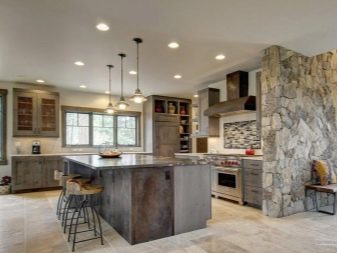
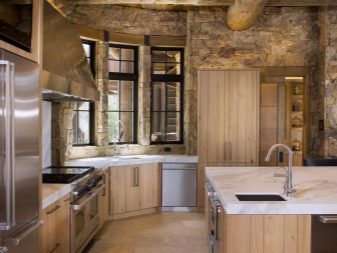
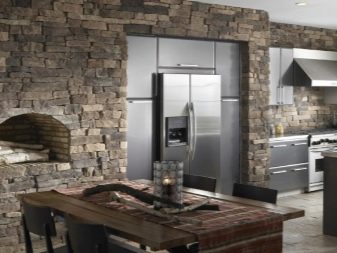
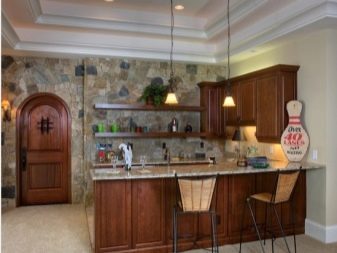
Facing artificial stone is an affordable analogue of a natural material that imitates the natural structure well and is highly resistant to moisture and mechanical damage. Unlike natural material, it has a huge selection of colors and is ideal for decorating walls, as well as an apron, arches. Despite the non-natural origin, the material is absolutely environmentally friendly. The most common types of artificial stone include agglomerate (consists of crumbs of marble, granite, limestone and quartz sand) and porcelain stoneware (includes minerals, spar and clay).
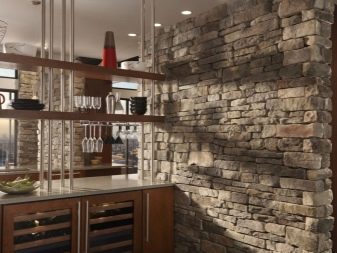

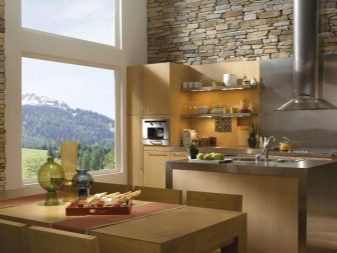
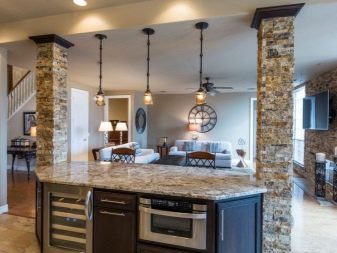
We consider each option individually.
- Porcelain tile. It is produced using modern technologies using the vibropressing method. The material is processed at high pressure and temperature, so that its performance is enhanced. Porcelain stoneware in many respects resembles glass or ceramic tile. It is durable, resistant to the negative effects of the external environment, but can lose its properties when exposed to hydrofluoric acid. As for the texture of the material, it can be matte, glossy, with a glazed surface and embossed inserts.
- Agglomerates. This subspecies of artificial stones includes those that include polyester resin. They represent a durable finishing material, but are unstable to the effects of chemicals containing an aggressive composition, and to abrasion. Therefore, agglomerates are not recommended for flooring. Most often, agglomerates are chosen for finishing bar counters, countertops and window sills.
A huge spread in the interior of kitchens has received and artificial stone made of colored concrete. It consists of plasticizers, pumice, expanded clay, sand and other additives. This material is suitable for finishing various surfaces inside the room.
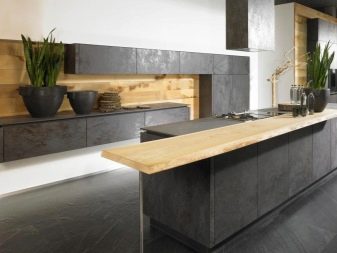
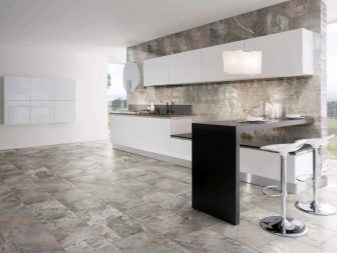
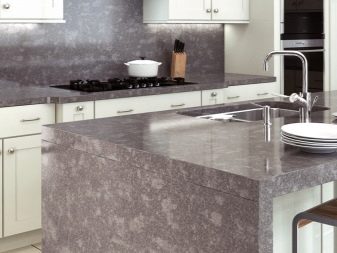

Ways to use
Today, many designers develop kitchen interiors using decorative stone. With it, the interior decoration takes on a chic look, and the room itself is filled with an atmosphere of comfort. In the interior of kitchens, this facing material is used as follows.
- Stone and tiles You can lay out all the walls, as well as a separate section. The stone wall in combination with the wallpaper looks interesting and stylish in design; decoration with stone and mural will become another unusual decision.This allows you to adjust the size of small rooms, visually expanding them. White stone, laid out horizontally, visually “draws” the space of the room.
The only thing that with this decor you can not use bright lighting - the beauty of the finish will emphasize a muffled, soft light.


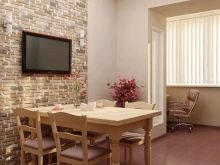
- For kitchens with a country style designIt is recommended to choose a combination of stone and wood. Solid wood furniture and stone wall cladding form an unusual ensemble, and the use of green shades will help strengthen the decorative effect.
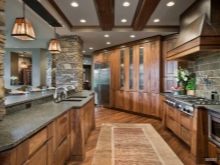
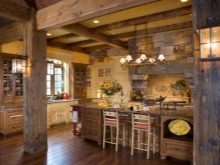
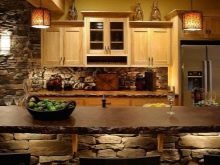
- If the apartment is planned to be renovated, then not only walls alone can be laid out with a stone, but also doorways, floor, ceiling and stair steps. Dressing should be done with beige and light gray material. In this case, granite and marble are well suited for decoration, since they are distinguished by nobleness and chic. It is also allowed to make separate inserts from malachite.
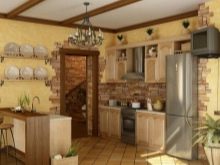
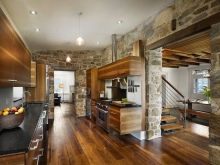
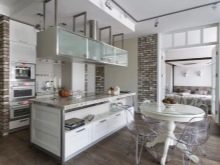
- For modern kitchens, characterized by smooth forms, horizontal lines and smoothed corners, monophonic (black or white) porcelain stoneware is ideal. To give the interior contrast, you need to perform a stone framing of niches and doorways. The use of colored concrete on the walls and porcelain stoneware on the floor will also be unusual.
To maintain a unified style, it is recommended to make inserts of decorative stone on the ceiling, which will be continued on the walls.
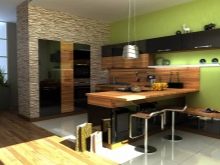
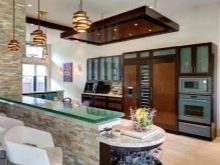
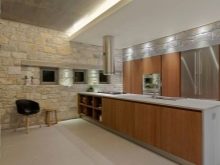
- Often a decorative stone lining the working areaincluding a cooking table, sink and stove. Thanks to this design approach, it is possible to maintain the integrity of the interior. It is recommended to decorate the apron in the kitchen with a stone that is resistant to high temperature and moisture. An apron made of this material brings a special touch to the design of the room, in addition, the seamless masonry allows you to protect the surface of the walls from the accumulation of dirt, simplifying cleaning.
In case of external damage to the stone (scratches and small chips), its appearance can be easily restored by polishing and polishing.
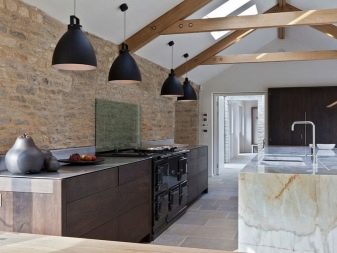
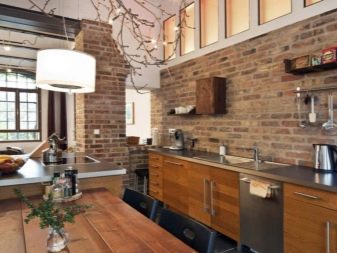
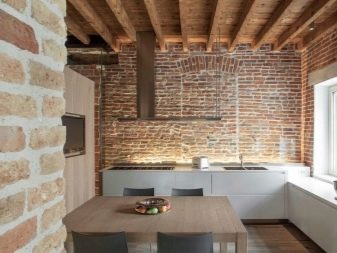
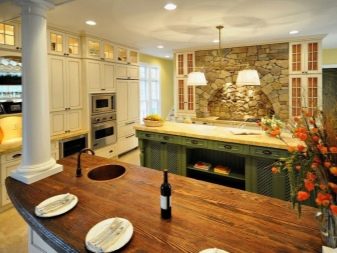
- The original decision is considered decorative stone lining of doorways and arches in the kitchen. This will not only give the entrance to the room an aesthetic appearance, but also perform a practical function, extending the operation of openings. As for decorating arches with natural stone, not everyone can perform it. This material must be laid on special mixtures and know the masonry scheme, otherwise you can spoil the material. In addition, facing in hard-to-reach places without the help of specialists cannot be carried out.
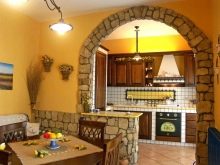
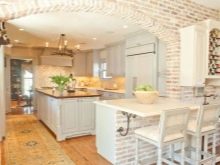
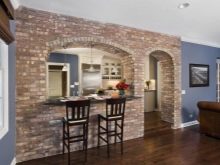
- It looks no less interesting in kitchens and panels made of stone. For this, a frame is installed on one of the selected walls, which will serve as a fringing, then stone compositions are laid out. To give such a decor element a “twist” with the help of a color game, laying a stone on the walls painted in contrasting colors. The combination of a stone surface with Venetian stucco looks elegant in modern design.

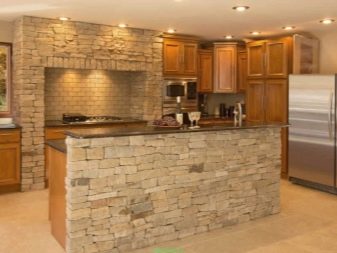
Beautiful examples
Decorative stone is widely used in various design projects of kitchens, as it has a natural look, natural texture and special energy that can create a positive mood. In the interior decoration of kitchens, stone is usually laid out with walls that act as a backdrop for an artistic solution. So, in the classical and Scandinavian style, wall cladding with white material (marble, granite, quartzite) will be an ideal choice. It will blend in well with wood paneling and dark brown or black flooring. In this design, the kitchen will acquire a certain charm.
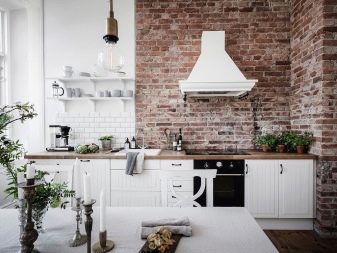

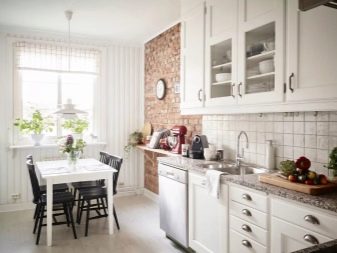
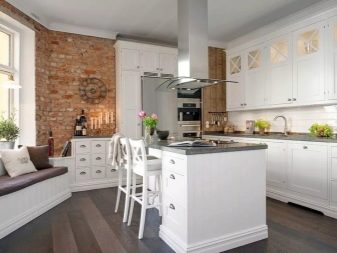
Consider another option. Walls are chosen as the main background, they are decorated with gray material (marble, granite or quartzite). A competent approach to the selection of furniture will help fill the room with luxury.If you place a countertop and a set with a glossy surface of dark red wood in the kitchen, you get a chic composition. As a floor covering, it is best to choose marble. If you wish, you can decorate one of the walls with Venetian stucco, the main thing is to choose its color correctly.
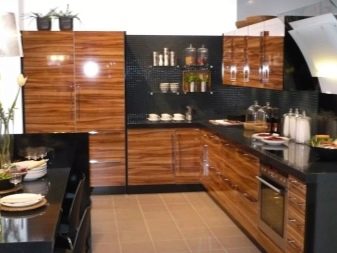
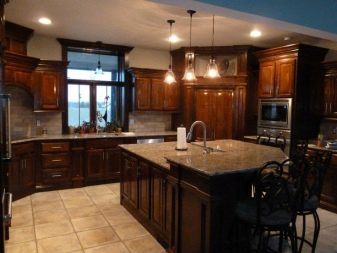
The masonry made of stone in the area of the kitchen apron will complement such an interior; it should go well with the set and countertop. For facing the working area, masonry made of marble and white onyx is well suited. The ceiling in this case needs to be installed suspended, snow-white. In addition, you should worry about the presence of good lighting, it must be placed both around the perimeter of the ceiling and on the cabinets. This will emphasize the natural beauty of the material and help visually expand the space in small kitchens.
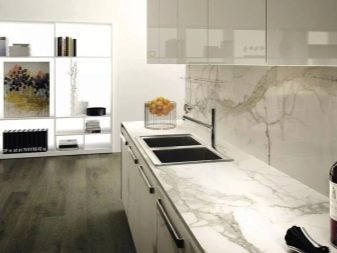
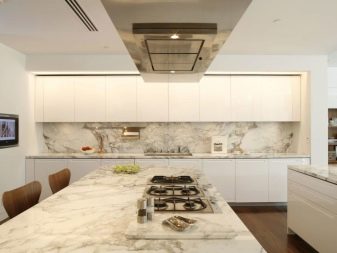
For lovers of loft style, the kitchen needs to be filled with shades of gray and red. To do this, all the walls must be faced with gray stone, and the apron area - red. To combine colors in this design will help a dark brown headset. In addition, the masonry should be performed on the floor and window sill, choosing a stone of a snow-white color. Light green textiles and indoor flowers will help to complement the interior.
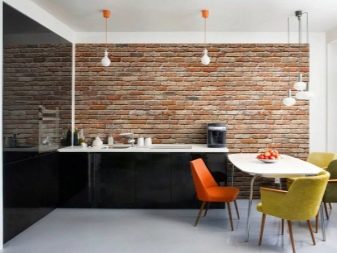

To get a chic kitchen design, you can make a kitchen in the style of a chalet using a decorative stone with a rough texture (jackdaws, wild boulder). If the kitchen is large, then the lining must be done with dark brown material. For small kitchens, stone trim in light gray is suitable. In addition to the walls, the cladding should be performed in the area of the hob, apron. The floor and countertop also need to be laid out with a stone, which should differ by several shades from the decoration of the walls.
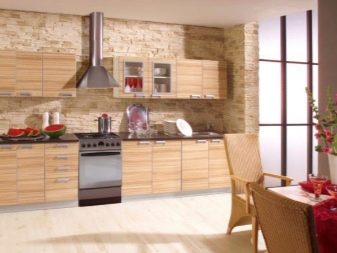
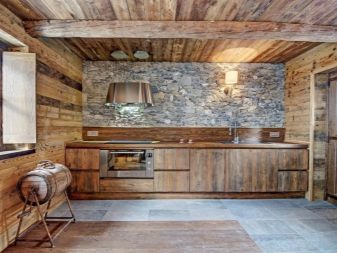
For those who prefer to see their kitchen in an unusual and modern design, wallpapering and stone wall decoration will be a good choice. This combination opens up great opportunities for creativity in design. Repeat in it is completely excluded, so each interior is exclusive. In addition, the wallpaper with the stone not only harmoniously combines, but also gives the room a respectable appearance, as well as increase the operational characteristics of the finish. In this case, it is important to correctly select the shades of the paintings and the texture of the stone. For example, if you use a material with a smooth surface, then the wallpaper should have a slight roughness.
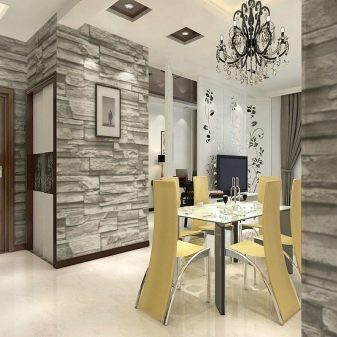

Decorating a kitchen apron with decorative stone in the video.
